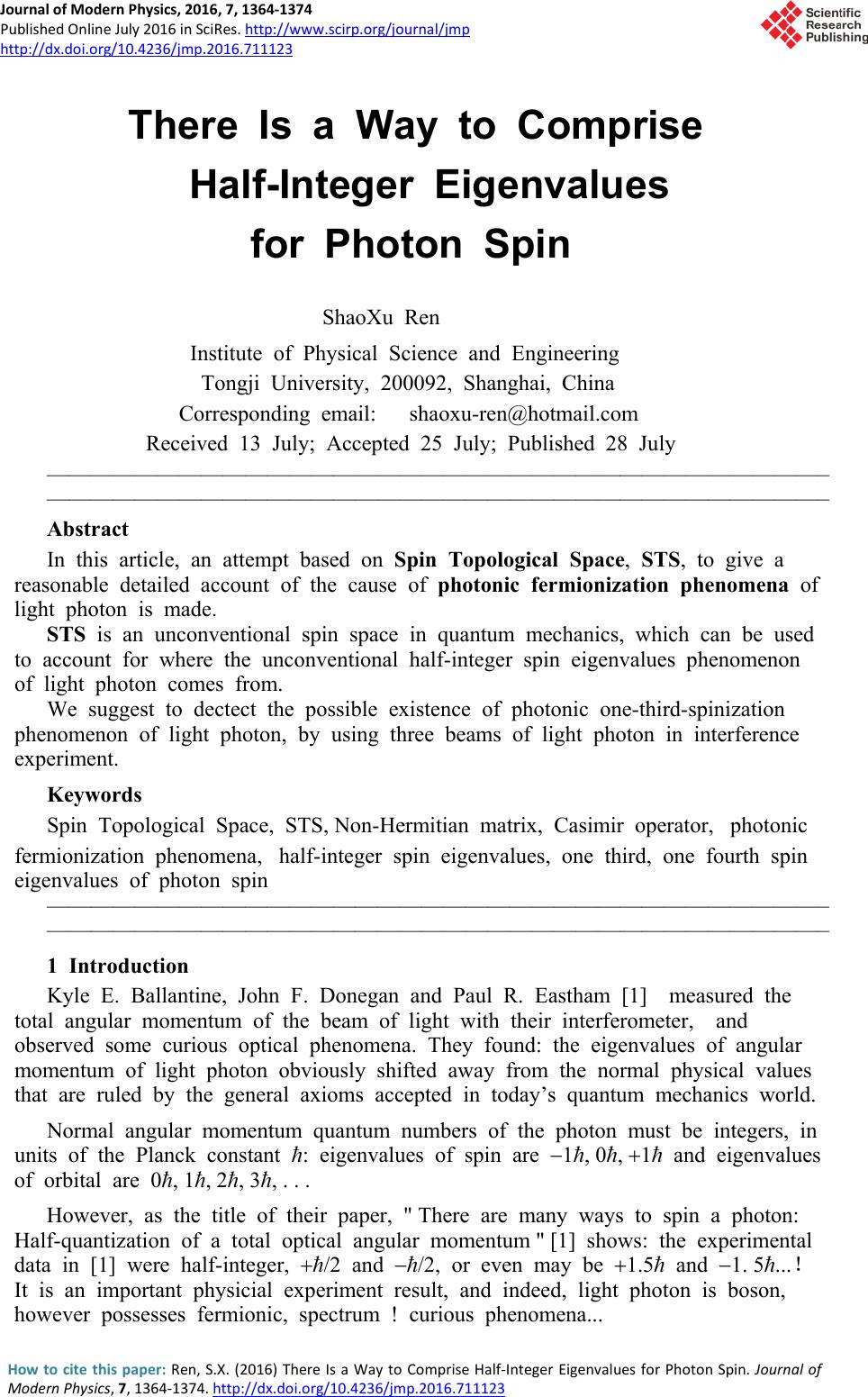 ThereIsaWaytoComprise Half-IntegerEigenvalues forPhotonSpin ShaoXuRen InstituteofPhysicalScienceandEngineering TongjiUniversity,200092,Shanghai,China Correspondingemail:shaoxu-ren@hotmail.com Received 13 July; Accepted 25 July; Published 28 July ———————————————————————————————————– ———————————————————————————————————– Abstract Inthisarticle,anattemptbasedonSpinTopologicalSpace,STS,togivea reasonabledetailedaccountofthecauseofphotonicfermionizationphenomenaof lightphotonismade. STSisanunconventionalspinspaceinquantummechanics,whichcanbeused toaccountforwheretheunconventionalhalf-integerspineigenvaluesphenomenon oflightphotoncomesfrom. Wesuggesttodectectthepossibleexistenceofphotonicone-third-spinization phenomenonoflightphoton,byusingthreebeamsoflightphotonininterference experiment. Keywords SpinTopologicalSpace,STS,Non-Hermitianmatrix,Casimiroperator,photonic fermionizationphenomena,half-integerspineigenvalues,onethird,onefourthspin eigenvaluesofphotonspin ———————————————————————————————————– ———————————————————————————————————– 1Introduction KyleE.Ballantine,JohnF.DoneganandPaulR.Eastham[1]measuredthe totalangularmomentumofthebeamoflightwiththeirinterferometer,and observedsomecuriousopticalphenomena.Theyfound:theeigenvaluesofangular momentumoflightphotonobviouslyshiftedawayfromthenormalphysicalvalues thatareruledbythegeneralaxiomsacceptedintoday’squantummechanicsworld. Normalangularmomentumquantumnumbersofthephotonmustbeintegers,in unitsofthePlanckconstant:eigenvaluesofspinare−1,0,1andeigenvalues oforbitalare0,1,2,3,... However,asthetitleoftheirpaper,"Therearemanywaystospinaphoton: Half-quantizationofatotalopticalangularmomentum"[1]shows:theexperimental datain[1]werehalf-integer,/2and−/2,orevenmaybe1.5and−1.5...! Itisanimportantphysicialexperimentresult,andindeed,lightphotonisboson, howeverpossessesfermionic,spectrum!curiousphenomena... Journal of Modern Physics, 2016, 7, 1364-1374 Published Online July 2016 in SciRes. http://www.scirp.org/journal/jmp http://dx.doi.org/10.4236/jmp.2016.711123 How to cite this paper: Ren, S.X. (2016) There Is a Way to Comprise Half-Integer Eigenvalues for Photon Spin. Journal of Modern Physics, 7, 1364-1374. http://dx.doi.org/10.4236/jmp.2016.711123 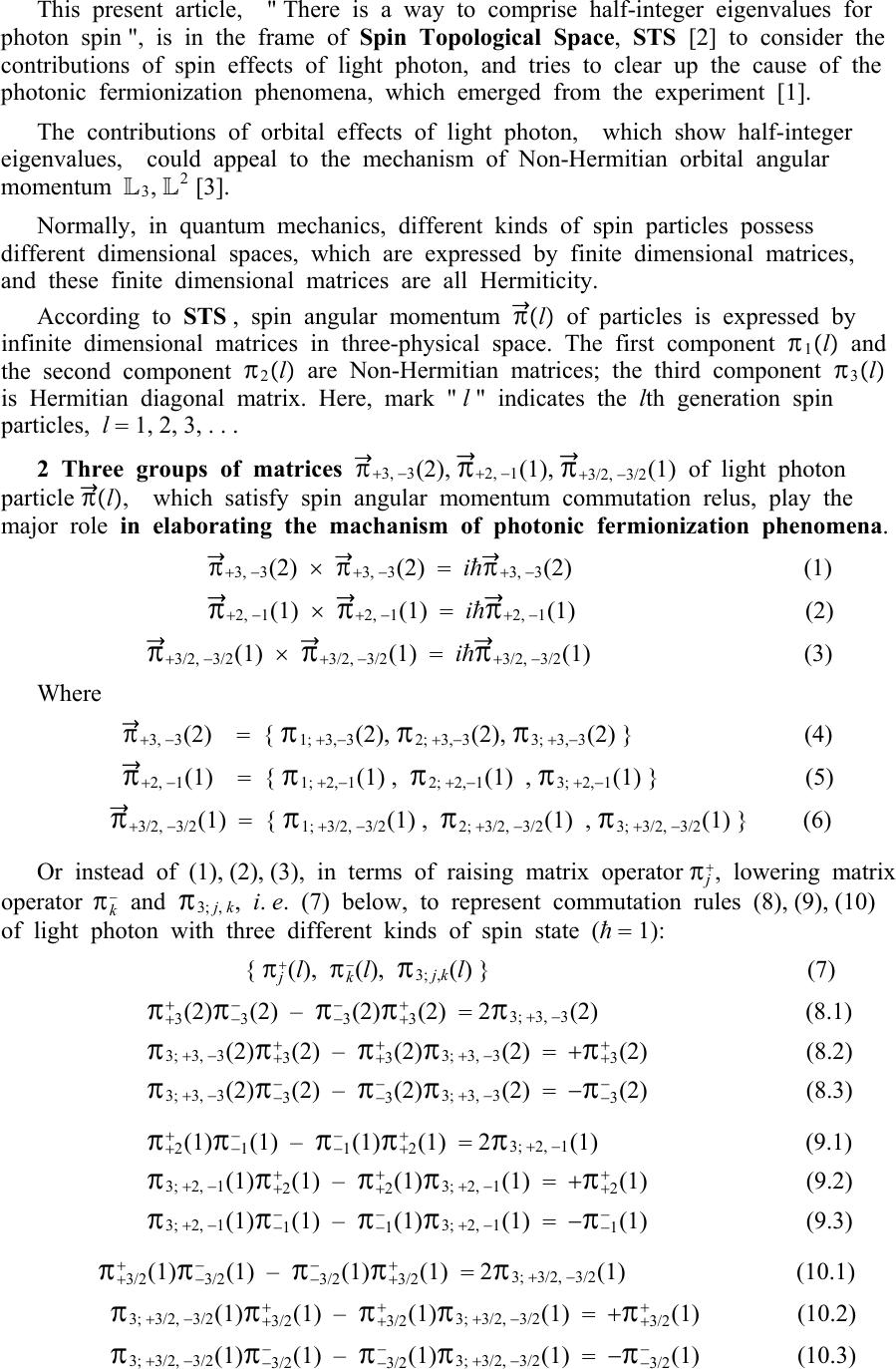 Thispresentarticle,"Thereisawaytocomprisehalf-integereigenvaluesfor photonspin",isintheframeofSpinTopologicalSpace,STS[2]toconsiderthe contributionsofspineffectsoflightphoton,andtriestoclearupthecauseofthe photonicfermionizationphenomena,whichemergedfromtheexperiment[1]. Thecontributionsoforbitaleffectsoflightphoton,whichshowhalf-integer eigenvalues,c ouldappealtothemechanismofNon-Hermitianorbitalangular momentumL 3 ,L 2 [3]. Normally,inquantummechanics,differentkindsofspinparticlespossess differentdimensionalspaces,whichareexpressedbyfinitedimensionalmatrices, andthesefinitedimensionalmatricesareallHermiticity. AccordingtoSTS,spinangularmomentum lofparticlesisexpressedby infinitedimensionalmatricesinthree-physicalspace.Thefirstcomponent 1 land thesecondcomponent 2 lareNon-Hermitianmatrices;thethirdcomponent 3 l isHermitiandiagonalmatrix.Here,mark"l"indicatesthelthgenerationspin particles,l1,2,3,... 2Threegroupsofmatrices 3,−3 (2), 2,−1 (1), 3/2,−3/2 (1)oflightphoton particle l,whichsatisfyspinangularmomentumcommutationrelus,playthe majorroleinelaboratingthemachanismofphotonicfermionizationphenomena. 3,−3 (2) 3,−3 (2)i 3,−3 (2)(1) 2,−1 (1) 2,−1 (1)i 2,−1 (1)(2) 3/2,−3/2 (1) 3/2,−3/2 (1)i 3/2,−3/2 (1)(3) Where 3,−3 (2){ 1;3,−3 (2), 2;3,−3 (2), 3;3,−3 (2)}(4) 2,−1 (1){ 1;2,−1 (1), 2;2,−1 (1), 3;2,−1 (1)}(5) 3/2,−3/2 (1){ 1;3/2,−3/2 (1), 2;3/2,−3/2 (1), 3;3/2,−3/2 (1)}(6) Orinsteadof(1),(2),(3),intermsofraisingmatrixoperator j ,loweringmatrix operator k − and 3;j,k ,i.e.(7)below,torepresentcommutationrules(8),(9),(10) oflightphotonwiththreedifferentkindsofspinstate(1): { j (l), k − (l), 3;j,k (l)}(7) 3 (2) −3 − (2)– −3 − (2) 3 (2)2 3;3,−3 (2)(8.1) 3;3,−3 (2) 3 (2)– 3 (2) 3;3,−3 (2) 3 (2)(8.2) 3;3,−3 (2) −3 − (2)– −3 − (2) 3;3,−3 (2)− −3 − (2)(8.3) 2 (1) −1 − (1)– −1 − (1) 2 (1)2 3;2,−1 (1)(9.1) 3;2,−1 (1) 2 (1)– 2 (1) 3;2,−1 (1) 2 (1)(9.2) 3;2,−1 (1) −1 − (1)– −1 − (1) 3;2,−1 (1)− −1 − (1)(9.3) 3/2 (1) −3/2 − (1)– −3/2 − (1) 3/2 (1)2 3;3/2,−3/2 (1)(10.1) 3;3/2,−3/2 (1) 3/2 (1)– 3/2 (1) 3;3/2,−3/2 (1) 3/2 (1)(10.2) 3;3/2,−3/2 (1) −3/2 − (1)– −3/2 − (1) 3;3/2,−3/2 (1)− −3/2 − (1)(10.3) 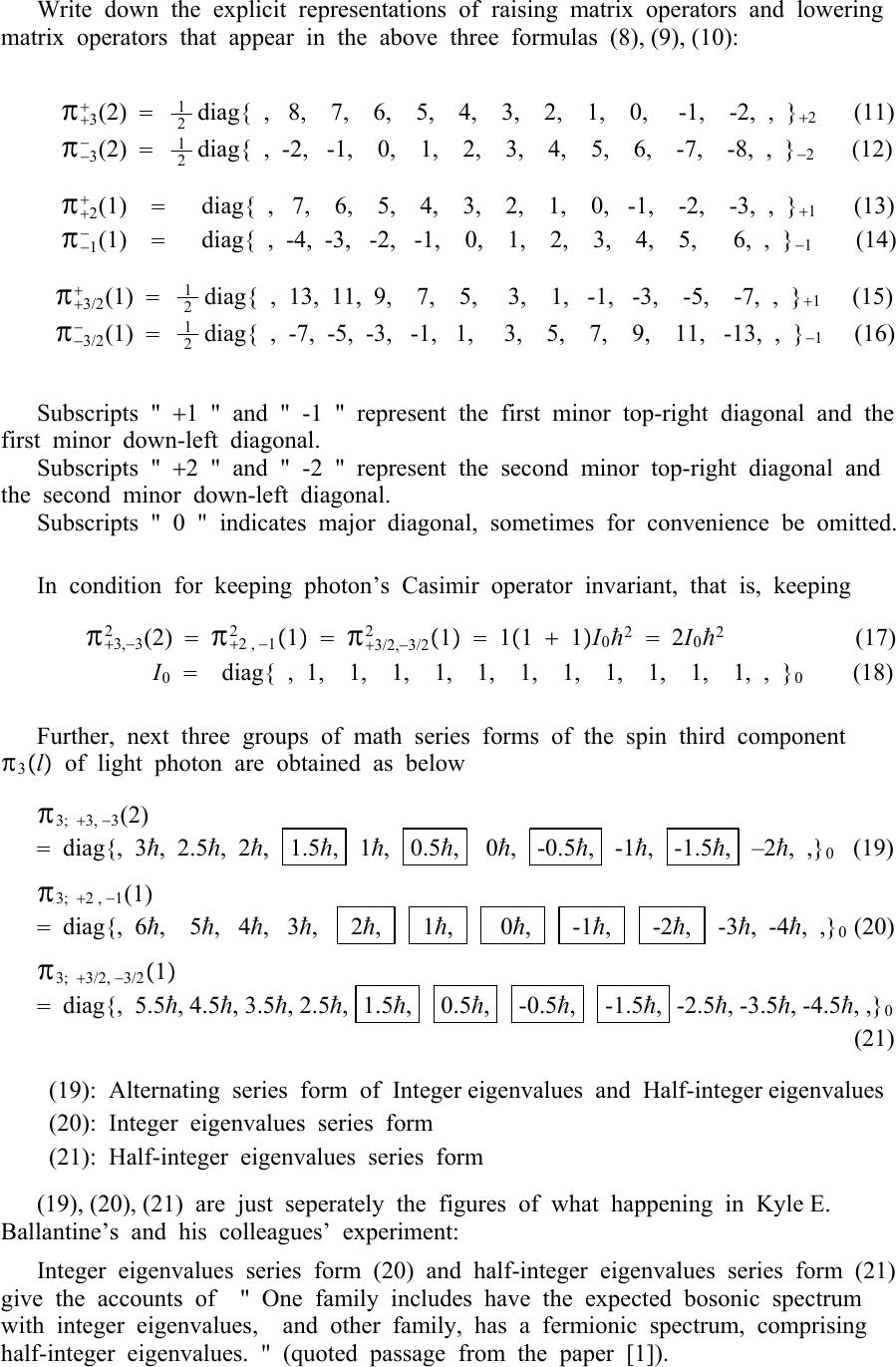 Writedowntheexplicitrepresentationsofraisingmatrixoperatorsandlowering matrixoperatorsthatappearintheabovethreef ormulas(8),(9),(10): 3 (2) 1 2 diag{,8,7,6,5,4,3,2,1,0,-1,-2,,} 2 (11) −3 − (2) 1 2 diag{,-2,-1,0,1,2,3,4,5,6,-7,-8,,} −2 (12) 2 (1)diag{,7,6,5,4,3,2,1,0,-1,-2,-3,,} 1 (13) −1 − (1)diag{,-4,-3,-2,-1,0,1,2,3,4,5,6,,} −1 (14) 3/2 (1) 1 2 diag{,13,11,9,7,5,3,1,-1,-3,-5,-7,,} 1 (15) −3/2 − (1) 1 2 diag{,-7,-5,-3,-1,1,3,5,7,9,11,-13,,} −1 (16) Subscripts"1"and"-1"representthef irstminortop-rightdiagonalandthe firstminordown-leftdiagonal. Subscripts"2"and"-2"representthesecondminortop-rightdiagonaland thesecondminordown-leftdiagonal. Subscripts"0"indicatesmajordiagonal,sometimesforconveniencebeomitted. Inconditionforkeepingphoton’sCasimiroperatorinvariant,thatis,keeping 3,−3 2 (2) 2,−1 2 1 3/2,−3/2 2 1111I 0 2 2I 0 2 (17) I 0 diag{,1,1,1,1,1,1,1,1,1,1,1,,} 0 (18) Further,nextthreegroupsofmathseriesformsofthespinthirdcomponent 3 loflightphotonareobtainedasbelow 3;3,−3 (2) diag{,3,2.5,2, 1.5,1,0.5,0,-0.5,-1,-1.5,–2,,} 0 (19) 3;2,−1 (1) diag{,6,5,4,3, 2,1,0,-1,-2,-3,-4,,} 0 (20) 3;3/2,−3/2 1 diag{,5.5,4.5,3.5,2.5, 1.5,0.5,-0.5,-1.5,-2.5,-3.5,-4.5,,} 0 (21) (19):AlternatingseriesformofIntegereigenvaluesandHalf-integereigenvalues (20):Integereigenvaluesseriesform (21):Half-integereigenvaluesseriesform (19),(20),(21)arejustseperatelythefiguresofwhathappeninginKyleE. Ballantine’sandhiscolleagues’experiment: Integereigenvaluesseriesform(20)andhalf-integereigenvaluesseriesform(21) givetheaccountsof"Onefamilyincludeshavetheexpectedbosonicspectrum withintegereigenvalues,a ndotherf amily,hasafermionicspectrum,comprising half-integereigenvalues."(quotedpassagefromthepaper[1]). 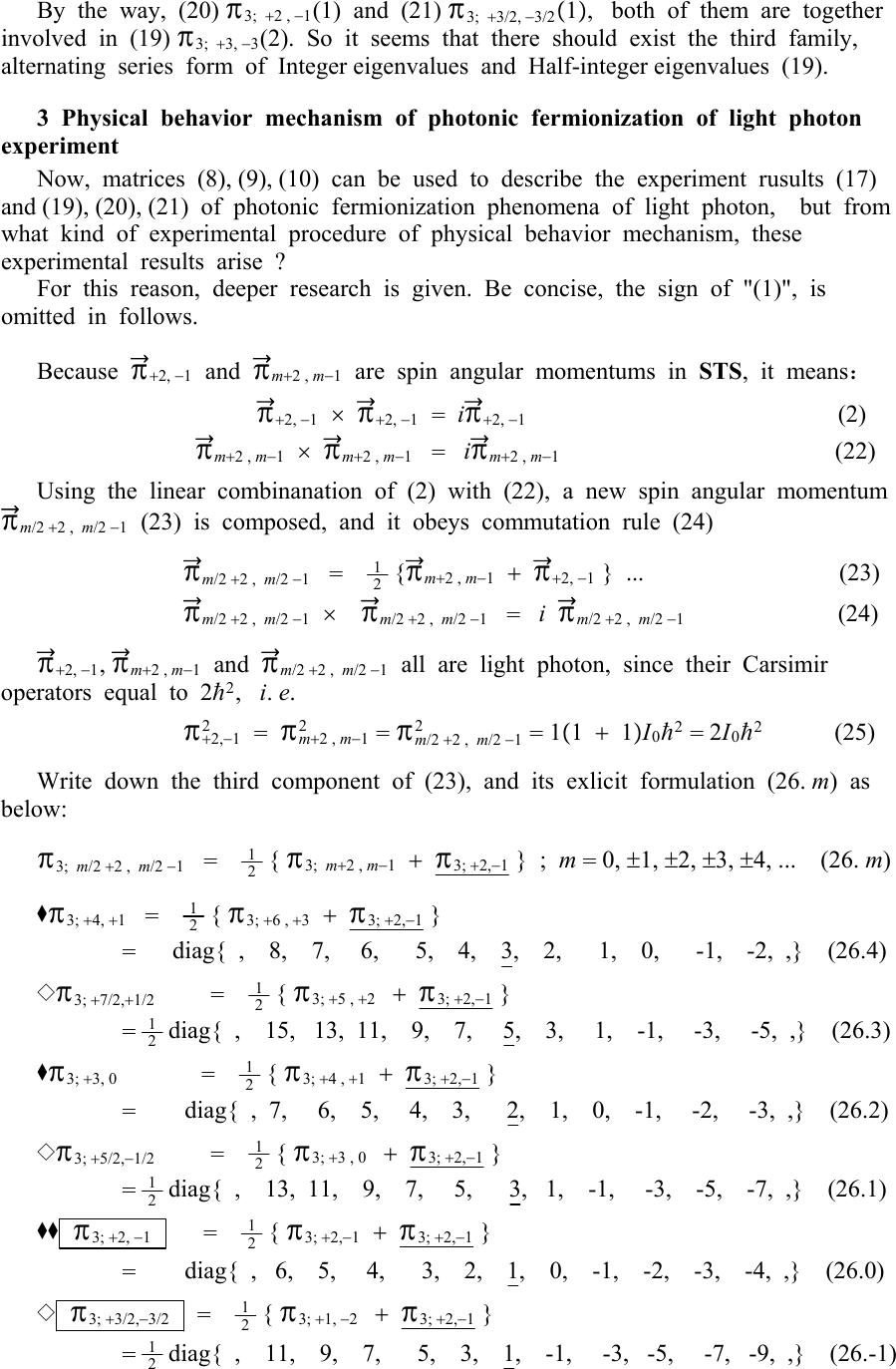 Bytheway,(20) 3;2,−1 (1)and(21) 3;3/2,−3/2 1,bothofthemaretogether involvedin(19) 3;3,−3 (2).Soitseemsthatthereshoulde xistthethirdfamily, alternatingseriesf ormofIntegereigenvaluesandHalf-integereigenvalues(19). 3Physicalbehaviormechanismofphotonicfermionizationoflightphoton experiment Now,matrices(8),(9),(10)canbeusedtodescribethee xperimentrusults(17) and(19),(20),(21)ofphotonicfermionizationphenomenaoflightphoton,butfrom whatkindofexperimentalprocedureofphysicalbehaviormechanism,these experimentalresultsarise? Forthisreason,deeperresearchisgiven.Beconcise,thesignof"(1)",is omittedinf ollows. Because 2,−1 and m2,m−1 arespinangularmomentumsinSTS,itmeans: 2,−1 2,−1 i 2,−1 (2) m2,m−1 m2,m−1 i m2,m−1 (22) Usingthelinearcombinanationof(2)with(22),anewspinangularmomentum m/22, m/2−1 (23)iscomposed,anditobeyscommutationrule(24) m/22, m/2−1 1 2 { m2,m−1 2,−1 }...(23) m/22, m/2−1 m/22, m/2−1 i m/22, m/2−1 (24) 2,−1 , m2,m−1 and m/22, m/2−1 allarelightphoton,sincetheirCarsimir operatorsequalto2 2 ,i.e. 2,−1 2 m2,m−1 2 m/22, m/2−1 2 111I 0 2 2I 0 2 (25) Writedownthethirdc omponentof(23),anditsexlicitformulation(26.m)as below: 3;m/22, m/2−1 1 2 { 3;m2,m−1 3;2,−1 };m0,1,2,3,4,...(26.m) 3;4,1 1 2 { 3;6,3 3;2,−1 } diag{,8,7,6,5,4, 3,2,1,0,-1,-2,,}(26.4) 3;7/2,1/2 1 2 { 3;5,2 3;2,−1 } 1 2 diag{,15,13,11,9,7,5,3,1,-1,-3,-5,,}(26.3) 3;3,0 1 2 { 3;4,1 3;2,−1 } diag{,7,6,5,4,3, 2,1,0,-1,-2,-3,,}(26.2) 3;5/2,−1/2 1 2 { 3;3,0 3;2,−1 } 1 2 diag{,13,11,9,7,5,3,1,-1,-3,-5,-7,,}(26.1) 3;2,−1 1 2 { 3;2,−1 3;2,−1 } diag{,6,5,4,3,2, 1,0,-1,-2,-3,-4,,}(26.0) 3;3/2,−3/2 1 2 { 3;1,−2 3;2,−1 } 1 2 diag{,11,9,7,5,3,1,-1,-3,-5,-7,-9,,}(26.-1) 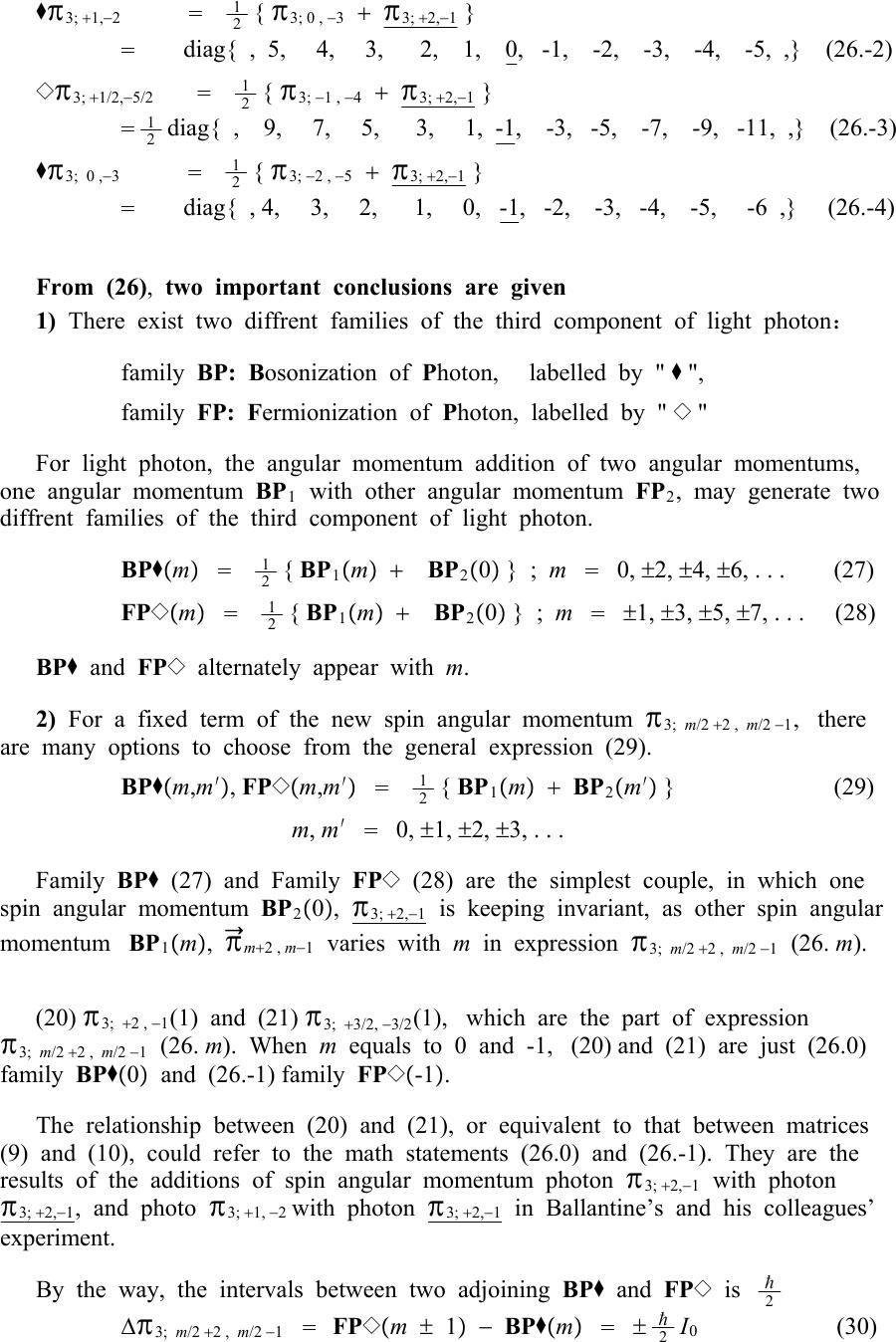 3;1,−2 1 2 { 3;0,−3 3;2,−1 } diag{,5,4,3,2,1, 0,-1,-2,-3,-4,-5,,}(26.-2) 3;1/2,−5/2 1 2 { 3;−1,−4 3;2,−1 } 1 2 diag{,9,7,5,3,1,-1,-3,-5,-7,-9,-11,,}(26.-3) 3;0,−3 1 2 { 3;−2,−5 3;2,−1 } diag{,4,3,2,1,0, -1,-2,-3,-4,-5,-6,}(26.-4) From(26),twoimportantconclusionsaregiven 1)Thereexisttwodiffrentfamiliesofthethirdcomponentoflightphoton: familyBP:BosonizationofPhoton,labelledby"", familyFP:FermionizationofPhoton,labelledby"" Forlightphoton,theangularmomentumadditionoftwoangularmomentums, oneangularmomentumBP 1 withotherangularmomentumFP 2 ,maygeneratetwo diffrentfamiliesofthethirdcomponentoflightphoton. BPm 1 2 {BP 1 mBP 2 0};m0,2,4,6,...(27) FPm 1 2 {BP 1 mBP 2 0};m1,3,5,7,...(28) BPandFPalternatelyappearwithm. 2)Forafixedtermofthenewspinangularmomentum 3;m/22, m/2−1 ,there aremanyoptionstochoosef romthegeneralexpression(29). BPm,m ′ ,FPm,m ′ 1 2 {BP 1 mBP 2 m ′ }(29) m,m ′ 0,1,2,3,... FamilyBP(27)andFamilyFP(28)arethesimplestcouple,inwhichone spinangularmomentumBP 2 0, 3;2,−1 iskeepinginvariant,asotherspinangular momentumBP 1 m, m2,m−1 varieswithminexpression 3;m/22, m/2−1 (26.m). (20) 3;2,−1 (1)and(21) 3;3/2,−3/2 (1),whicharethepartofexpression 3;m/22, m/2−1 (26.m).Whenmequalsto0and-1,(20)and(21)arejust(26.0) familyBP0and(26.-1)familyFP-1. Therelationshipbetween(20)and(21),orequivalenttothatbetweenmatrices (9)and(10),couldrefertothemathstatements(26.0)and(26.-1).Theyarethe resultsoftheadditionsofspinangularmomentumphoton 3;2,−1 withphoton 3;2,−1 ,andphoto 3;1,−2 withphoton 3;2,−1 inBallantine’sandhiscolleagues’ experiment. Bytheway,theintervalsbetweentwoa djoiningBPandFPis 2 Δ 3;m/22, m/2−1 FPm1−BPm 2 I 0 (30) 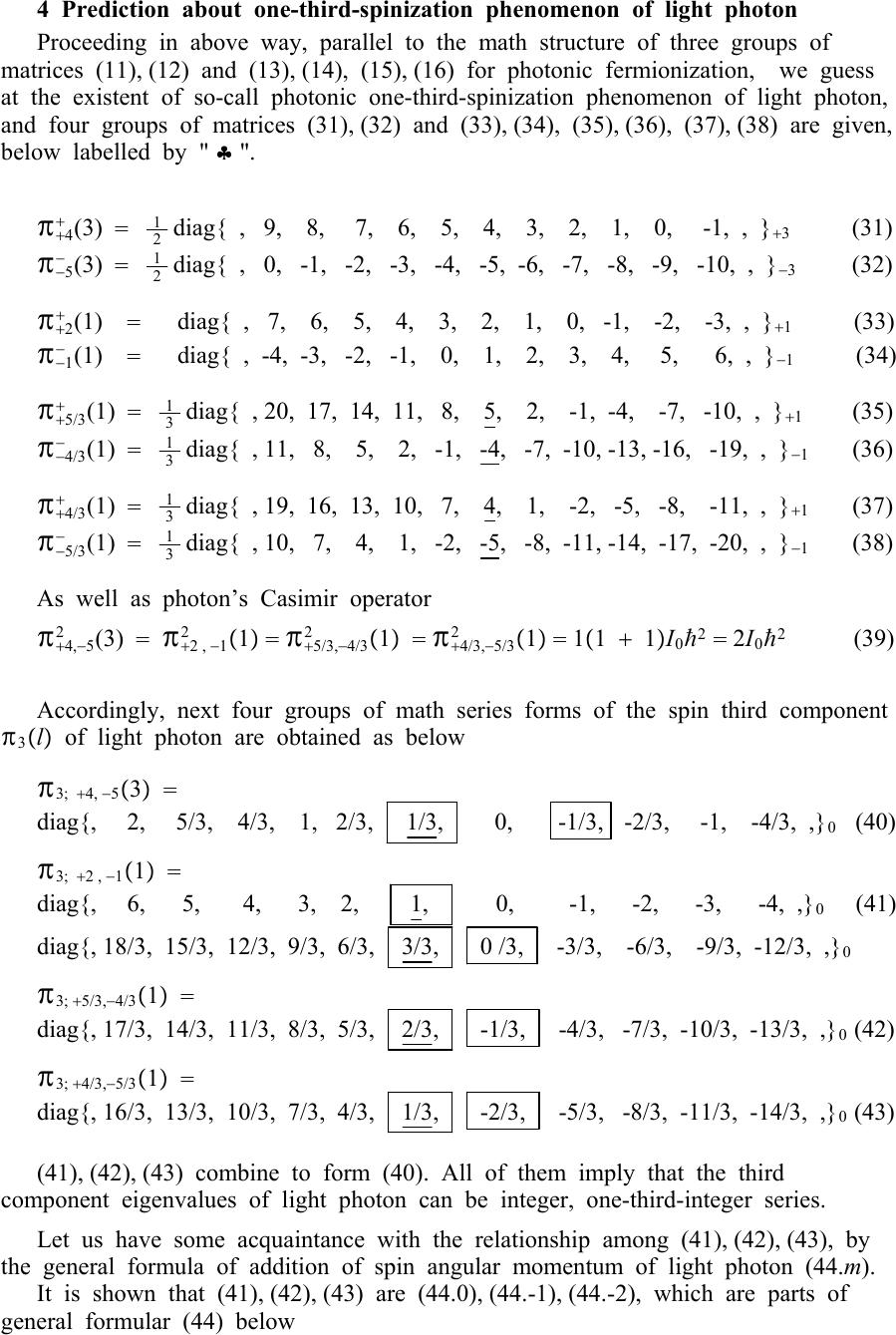 4Predictionaboutone-third-spinizationphenomenonoflightphoton Proceedinginaboveway,paralleltothemathstructureofthreegroupsof matrices(11),(12)and(13),(14),(15),(16)f orphotonicfermionization,weguess attheexistentofso-callphotonicone-third-spinizationphenomenonoflightphoton, andfourgroupsofmatrices(31),(32)and(33),(34),(35),(36),(37),(38)aregiven, belowlabelledby"♣". 4 (3) 1 2 diag{,9,8,7,6,5,4,3,2,1,0,-1,,} 3 (31) −5 − (3) 1 2 diag{,0,-1,-2,-3,-4,-5,-6,-7,-8,-9,-10,,} −3 (32) 2 (1)diag{,7,6,5,4,3,2,1,0,-1,-2,-3,,} 1 (33) −1 − (1)diag{,-4,-3,-2,-1,0,1,2,3,4,5,6,,} −1 (34) 5/3 (1) 1 3 diag{,20,17,14,11,8,5,2,-1,-4,-7,-10,,} 1 (35) −4/3 − (1) 1 3 diag{,11,8,5,2,-1,-4,-7,-10,-13,-16,-19,,} −1 (36) 4/3 (1) 1 3 diag{,19,16,13,10,7,4,1,-2,-5,-8,-11,,} 1 (37) −5/3 − (1) 1 3 diag{,10,7,4,1,-2,-5,-8,-11,-14,-17,-20,,} −1 (38) Aswellasphoton’sCasimiroperator 4,−5 2 (3) 2,−1 2 1 5/3,−4/3 2 1 4/3,−5/3 2 1111I 0 2 2I 0 2 (39) Accordingly,nextfourgroupsofmathseriesformsofthespinthirdcomponent 3 loflightphotonareobtainedasbelow 3;4,−5 3 diag{,2,5/3,4/3,1,2/3, 1/3,0,-1/3,-2/3,-1,-4/3,,} 0 (40) 3;2,−1 1 diag{,6,5,4,3,2, 1,0,-1,-2,-3,-4,,} 0 (41) diag{,18/3,15/3,12/3,9/3,6/3, 3/3,0/3,-3/3,-6/3,-9/3,-12/3,,} 0 3;5/3,−4/3 1 diag{,17/3,14/3,11/3,8/3,5/3, 2/3,-1/3,-4/3,-7/3,-10/3,-13/3,,} 0 (42) 3;4/3,−5/3 1 diag{,16/3,13/3,10/3,7/3,4/3, 1/3,-2/3,-5/3,-8/3,-11/3,-14/3,,} 0 (43) (41),(42),(43)combinetoform(40).Allofthemimplythatthethird componenteigenvaluesoflightphotoncanbeinteger,one-third-integerseries. Letushavesomeacquaintancewiththerelationshipamong(41),(42),(43),by thegeneralformulaofadditionofspinangularmomentumoflightphoton(44.m). Itisshownthat(41),(42),(43)are(44.0),(44.-1),(44.-2),whicharepartsof generalformular(44)below 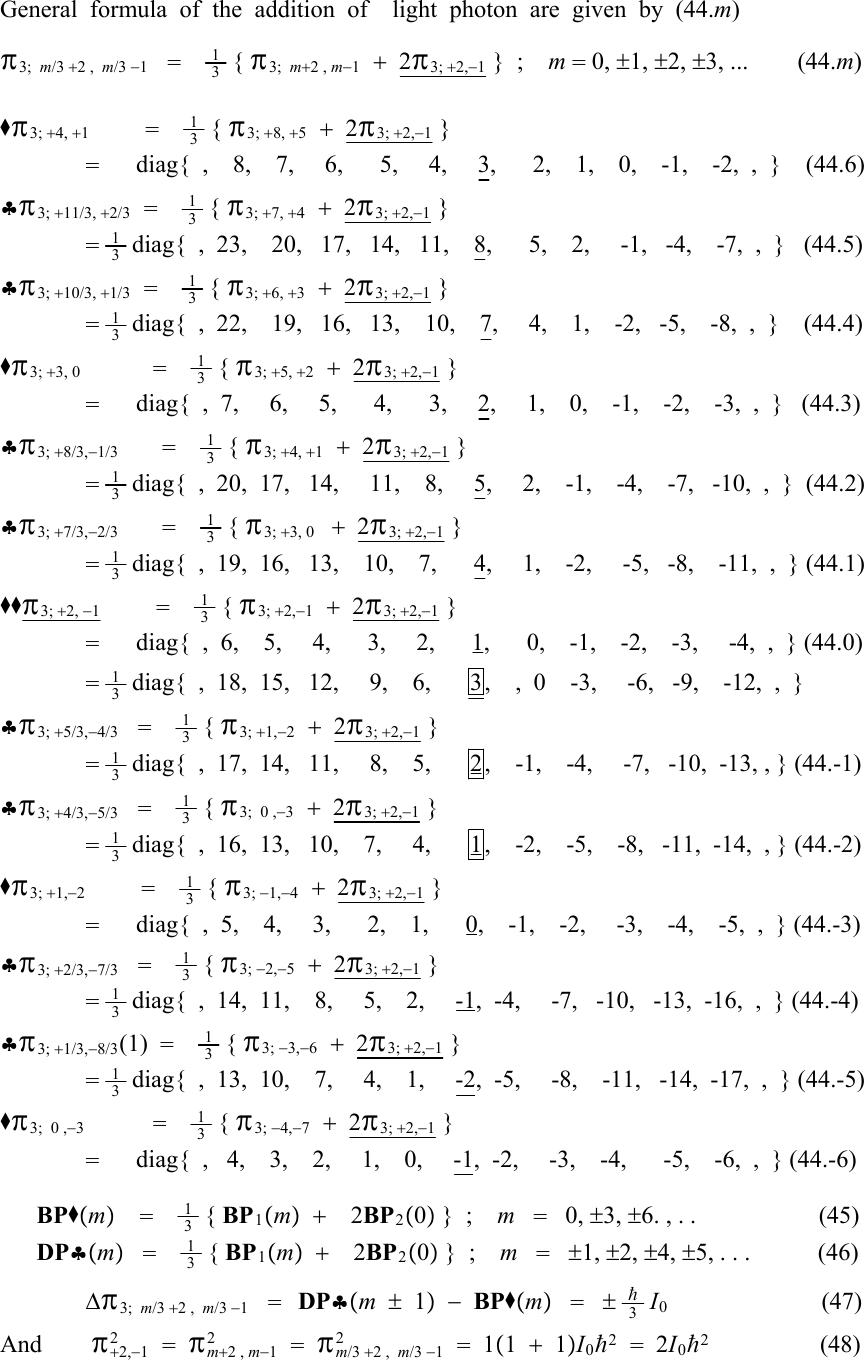 Generalformulaoftheadditionoflightphotonaregivenby(44.m) 3;m/32, m/3−1 1 3 { 3;m2,m−1 2 3;2,−1 }; m0,1,2,3,...(44.m) 3;4,1 1 3 { 3;8,5 2 3;2,−1 } diag{,8,7,6,5,4, 3,2,1,0,-1,-2,,}(44.6) ♣ 3;11/3,2/3 1 3 { 3;7,4 2 3;2,−1 } 1 3 diag{,23,20,17,14,11,8,5,2,-1,-4,-7,,}(44.5) ♣ 3;10/3,1/3 1 3 { 3;6,3 2 3;2,−1 } 1 3 diag{,22,19,16,13,10,7,4,1,-2,-5,-8,,}(44.4) 3;3,0 1 3 { 3;5,2 2 3;2,−1 } diag{,7,6,5,4,3, 2,1,0,-1,-2,-3,,}(44.3) ♣ 3;8/3,−1/3 1 3 { 3;4,1 2 3;2,−1 } 1 3 diag{,20,17,14,11,8,5,2,-1,-4,-7,-10,,}(44.2) ♣ 3;7/3,−2/3 1 3 { 3;3,0 2 3;2,−1 } 1 3 diag{,19,16,13,10,7,4,1,-2,-5,-8,-11,,}(44.1) 3;2,−1 1 3 { 3;2,−1 2 3;2,−1 } diag{,6,5,4,3,2, 1,0,-1,-2,-3,-4,,}(44.0) 1 3 diag{,18,15,12,9,6,3, ,0 -3,-6,-9, -12,,} ♣ 3;5/3,−4/3 1 3 { 3;1,−2 2 3;2,−1 } 1 3 diag{,17,14,11,8,5,2,-1,-4,-7,-10,-13,,}(44.-1) ♣ 3;4/3,−5/3 1 3 { 3;0,−3 2 3;2,−1 } 1 3 diag{,16,13,10,7,4,1,-2,-5,-8,-11,-14,,}(44.-2) 3;1,−2 1 3 { 3;−1,−4 2 3;2,−1 } diag{,5,4,3,2,1, 0,-1,-2,-3,-4,-5,,}(44.-3) ♣ 3;2/3,−7/3 1 3 { 3;−2,−5 2 3;2,−1 } 1 3 diag{,14,11,8,5,2,-1,-4,-7,-10,-13,-16,,}(44.-4) ♣ 3;1/3,−8/3 (1) 1 3 { 3;−3,−6 2 3;2,−1 } 1 3 diag{,13,10,7,4,1,-2,-5,-8,-11,-14,-17,,}(44.-5) 3;0,−3 1 3 { 3;−4,−7 2 3;2,−1 } diag{,4,3,2,1,0, -1,-2,-3,-4,-5,-6,,}(44.-6) BPm 1 3 {BP 1 m2BP 2 0}; m0,3,6.,..(45) DP♣m 1 3 {BP 1 m2BP 2 0}; m1,2,4,5,...(46) Δ 3;m/32, m/3−1 DP♣m1−BPm 3 I 0 (47) And 2,−1 2 m2,m−1 2 m/32, m/3−1 2 111I 0 2 2I 0 2 (48) 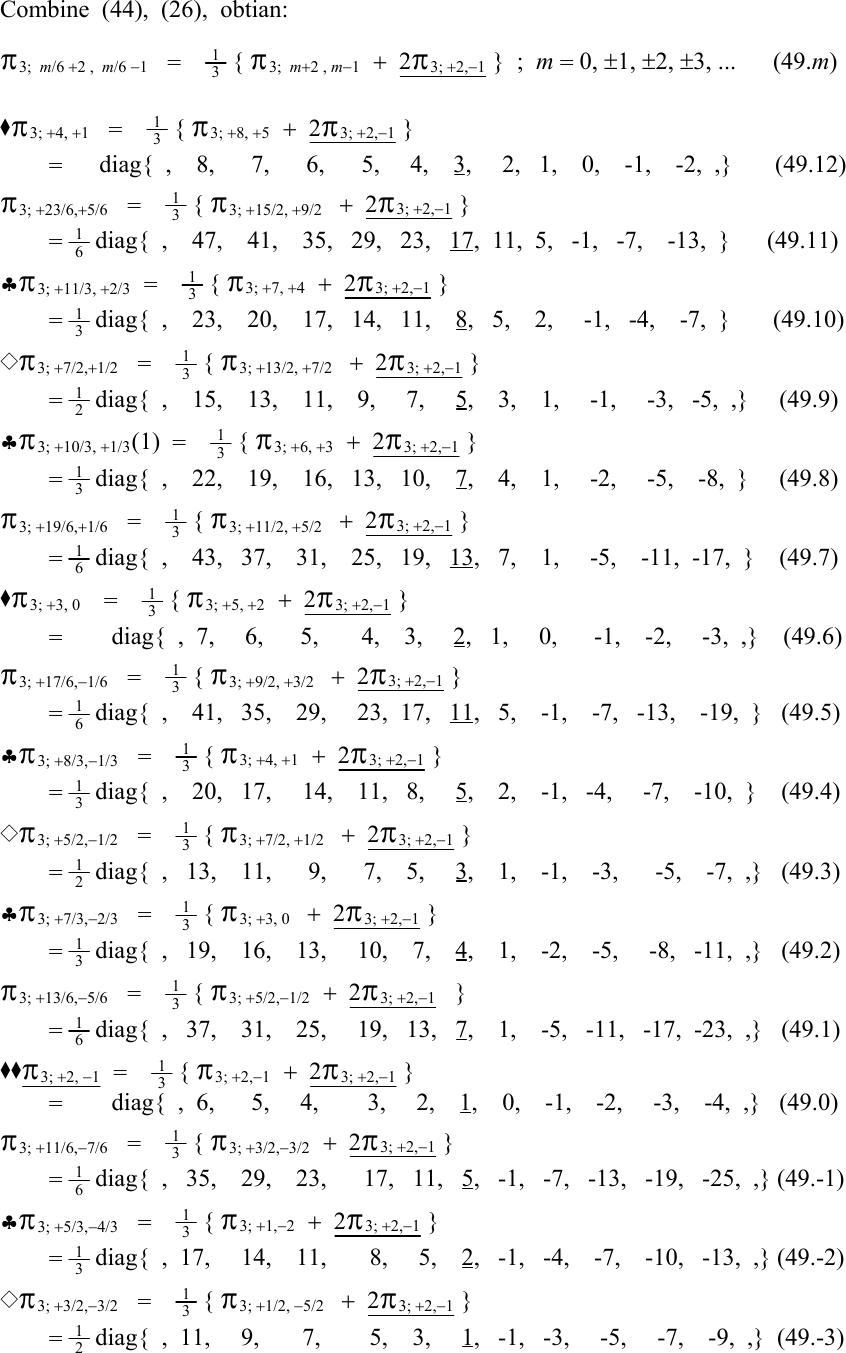 Combine(44),(26),obtian: 3;m/62, m/6−1 1 3 { 3;m2,m−1 2 3;2,−1 };m0,1,2,3,...(49. m) 3;4,1 1 3 { 3;8,5 2 3;2,−1 } diag{,8,7,6,5,4, 3,2,1,0,-1,-2,,}(49.12) 3;23/6,5/6 1 3 { 3;15/2,9/2 2 3;2,−1 } 1 6 diag{,47,41,35,29,23,17,11,5,-1,-7,-13,}(49.11) ♣ 3;11/3,2/3 1 3 { 3;7,4 2 3;2,−1 } 1 3 diag{,23,20,17,14,11,8,5,2,-1,-4,-7,}(49.10) 3;7/2,1/2 1 3 { 3;13/2,7/2 2 3;2,−1 } 1 2 diag{,15,13,11,9,7,5,3,1,-1,-3,-5,,}(49.9) ♣ 3;10/3,1/3 (1) 1 3 { 3;6,3 2 3;2,−1 } 1 3 diag{,22,19,16,13,10,7,4,1,-2,-5,-8,}(49.8) 3;19/6,1/6 1 3 { 3;11/2,5/2 2 3;2,−1 } 1 6 diag{,43,37,31,25,19,13,7,1,-5,-11,-17,}(49.7) 3;3,0 1 3 { 3;5,2 2 3;2,−1 } diag{,7,6,5,4,3, 2,1,0,-1,-2,-3,,}(49.6) 3;17/6,−1/6 1 3 { 3;9/2,3/2 2 3;2,−1 } 1 6 diag{,41,35,29,23,17,11,5,-1,-7,-13,-19,}(49.5) ♣ 3;8/3,−1/3 1 3 { 3;4,1 2 3;2,−1 } 1 3 diag{,20,17,14,11,8,5,2,-1,-4,-7,-10,}(49.4) 3;5/2,−1/2 1 3 { 3;7/2,1/2 2 3;2,−1 } 1 2 diag{,13,11,9,7,5,3,1,-1,-3,-5,-7,,}(49.3) ♣ 3;7/3,−2/3 1 3 { 3;3,0 2 3;2,−1 } 1 3 diag{,19,16,13,10,7,4,1,-2,-5,-8,-11,,}(49.2) 3;13/6,−5/6 1 3 { 3;5/2,−1/2 2 3;2,−1 } 1 6 diag{,37,31,25,19,13,7,1,-5,-11,-17,-23,,}(49.1) 3;2,−1 1 3 { 3;2,−1 2 3;2,−1 } diag{,6,5,4,3,2,1,0,-1,-2,-3,-4,,}(49.0) 3;11/6,−7/6 1 3 { 3;3/2,−3/2 2 3;2,−1 } 1 6 diag{,35,29,23,17,11,5,-1,-7,-13,-19,-25,,}(49.-1) ♣ 3;5/3,−4/3 1 3 { 3;1,−2 2 3;2,−1 } 1 3 diag{,17,14,11,8,5,2,-1,-4,-7,-10,-13,,}(49.-2) 3;3/2,−3/2 1 3 { 3;1/2,−5/2 2 3;2,−1 } 1 2 diag{,11,9,7,5,3,1,-1,-3,-5,-7,-9,,}(49.-3) 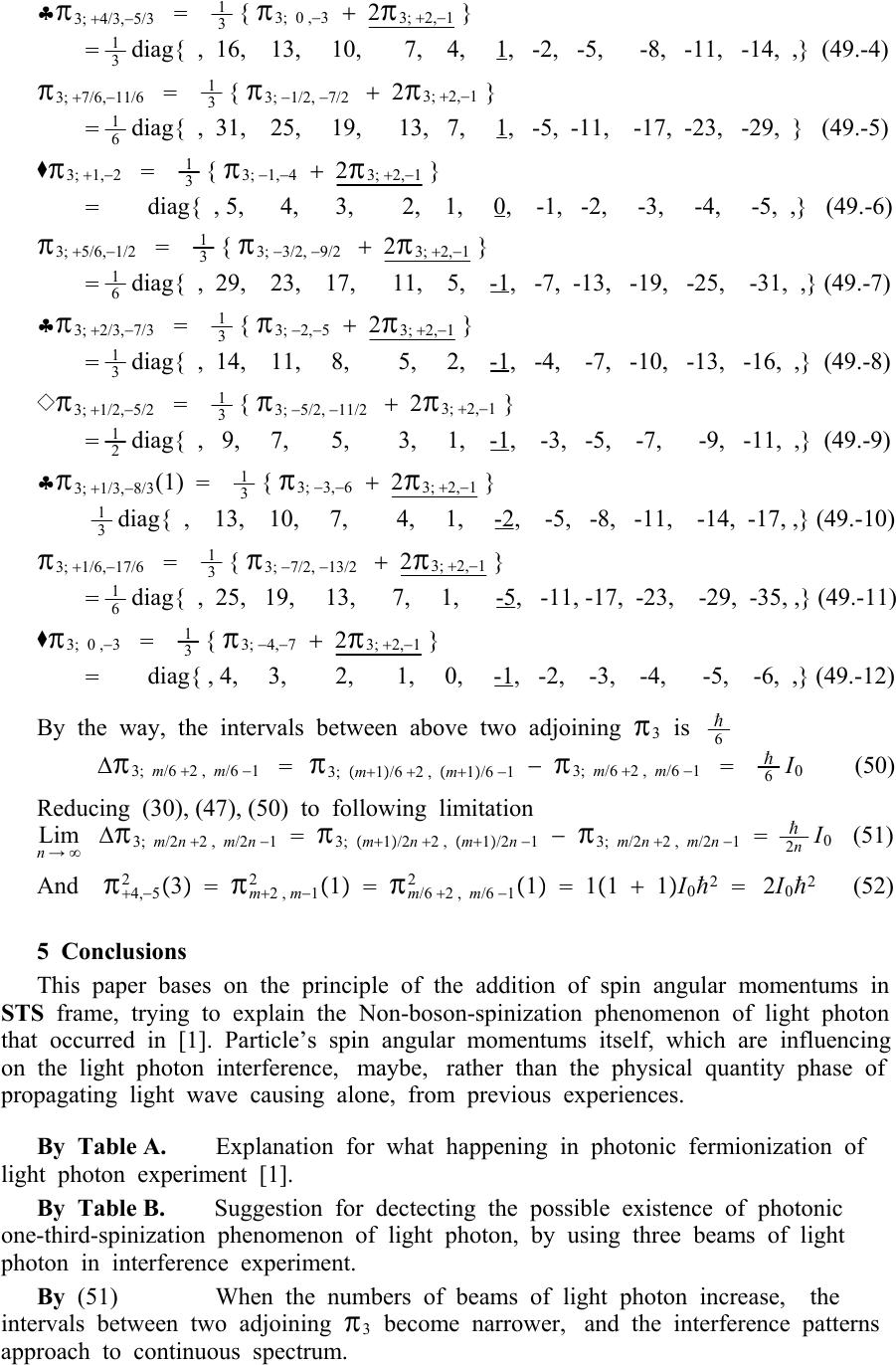 ♣ 3;4/3,−5/3 1 3 { 3;0,−3 2 3;2,−1 } 1 3 diag{,16,13,10,7,4,1,-2,-5,-8,-11,-14,,}(49.-4) 3;7/6,−11/6 1 3 { 3;−1/2,−7/2 2 3;2,−1 } 1 6 diag{,31,25,19,13,7,1,-5,-11,-17,-23,-29,}(49.-5) 3;1,−2 1 3 { 3;−1,−4 2 3;2,−1 } diag{,5,4,3,2,1, 0,-1,-2,-3,-4,-5,,}(49.-6) 3;5/6,−1/2 1 3 { 3;−3/2,−9/2 2 3;2,−1 } 1 6 diag{,29,23,17,11,5,-1,-7,-13,-19,-25,-31,,}(49.-7) ♣ 3;2/3,−7/3 1 3 { 3;−2,−5 2 3;2,−1 } 1 3 diag{,14,11,8,5,2,-1,-4,-7,-10,-13,-16,,}(49.-8) 3;1/2,−5/2 1 3 { 3;−5/2,−11/2 2 3;2,−1 } 1 2 diag{,9,7,5,3,1,-1,-3,-5,-7,-9,-11,,}(49.-9) ♣ 3;1/3,−8/3 (1) 1 3 { 3;−3,−6 2 3;2,−1 } 1 3 diag{,13,10,7,4,1,-2,-5,-8,-11,-14,-17,,}(49.-10) 3;1/6,−17/6 1 3 { 3;−7/2,−13/2 2 3;2,−1 } 1 6 diag{,25,19,13,7,1,-5,- 11,-17,-23,-29,-35,,}(49.-11) 3;0,−3 1 3 { 3;−4,−7 2 3;2,−1 } diag{,4,3,2,1,0, -1,-2,-3,-4,-5,-6,,}(49.-12) Bytheway,theintervalsbetweenabovetwoadjoining 3 is 6 Δ 3;m/62, m/6−1 3;m1/62, m1/6−1 − 3;m/62, m/6−1 6 I 0 (50) Reducing(30),(47),(50)tofollowinglimitation n LimΔ 3;m/2n2, m/2n−1 3;m1/2n2, m1/2n−1 − 3;m/2n2, m/2n−1 2n I 0 (51) And 4,−5 2 3 m2,m−1 2 1 m/62, m/6−1 2 1111I 0 2 2I 0 2 (52) 5Conclusions Thispaperbasesontheprincipleoftheadditionofspinangularmomentumsin STSframe,tryingtoexplaintheNon-boson-spinizationphenomenonoflightphoton thatoccurredin[1].Particle’sspinangularmomentumsitself,whichareinfl uencing onthelightphotoninterference,maybe,ratherthanthephysicalquantityphaseof propagatinglightwavecausingalone,frompreviousexperiences. ByTableA.Explanationforwhathappeninginphotonicfermionizationof lightphotonexperiment[1]. ByTableB.Suggestionfordectectingthepossibleexistenceofphotonic one-third-spinizationphenomenonoflightphoton,byusingthreebeamsoflight photonininterferenceexperiment. By(51)Whenthenumbersofbeamsoflightphotonincrease,the intervalsbetweentwoa djoining 3 becomenarrower,andtheinterferencepatterns approachtocontinuousspectrum. 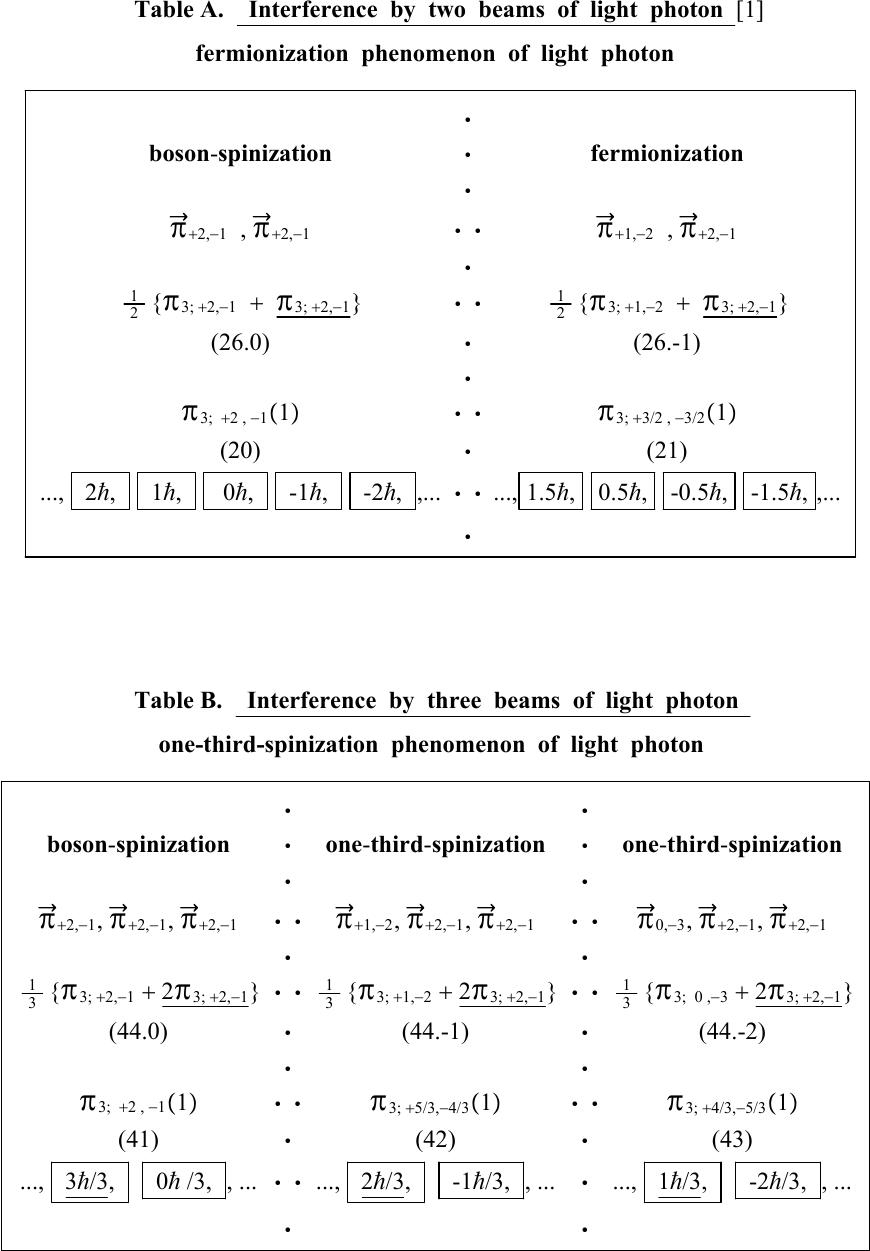 TableA.Interferencebytwobeamsoflightphoton[1] fermionizationphenomenonoflightphoton boson-spinizationfermionization 2,−1 , 2,−1 1,−2 , 2,−1 1 2 { 3;2,−1 3;2,−1 } 1 2 { 3;1,−2 3;2,−1 } (26.0)(26.-1) 3;2,−1 1 3;3/2,−3/2 1 (20)(21) ...,2,1,0,-1,-2,,......,1.5,0.5,-0.5,-1.5,,... TableB. Interferencebythreebeamsoflightphoton one-third-spinizationphenomenonoflightphoton boson-spinizationone-third-spinizationone-third-spinization 2,−1 , 2,−1 , 2,−1 1,−2 , 2,−1 , 2,−1 0,−3 , 2,−1 , 2,−1 1 3 { 3;2,−1 2 3;2,−1 } 1 3 { 3;1,−2 2 3;2,−1 } 1 3 { 3;0,−3 2 3;2,−1 } (44.0)(44.-1)(44.-2) 3;2,−1 1 3;5/3,−4/3 1 3;4/3,−5/3 1 (41)(42)(43) ..., 3/3,0/3,,......,2/3,-1/3,,... ...,1/3,-2/3,,... 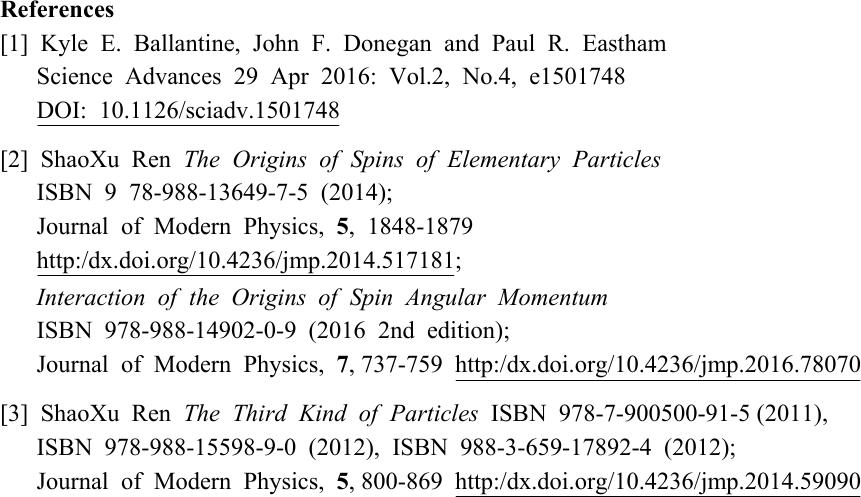 References [1]KyleE.Ballantine,JohnF.DoneganandPaulR.Eastham ScienceAdvances29Apr2016:Vol.2,No.4,e1501748 DOI:10.1126/sciadv.1501748 [2]ShaoXuRenTheOriginsofSpinsofElementaryParticles ISBN978-988-13649-7-5(2014); JournalofModernPhysics,5,1848-1879 http:/dx.doi.org/10.4236/jmp.2014.517181; InteractionoftheOriginsofSpinAngularMomentum ISBN978-988-14902-0-9(20162ndedition); JournalofModernPhysics,7,737-759 http:/dx.doi.org/10.4236/jmp.2016.78070 [3]ShaoXuRenTheThirdKindofParticlesISBN978-7-900500-91-5(2011), ISBN978-988-15598-9-0(2012),ISBN988-3-659-17892-4(2012); JournalofModernPhysics,5,800-869 http:/dx.doi.org/10.4236/jmp.2014.59090  Submit or recommend next manuscript to SCIRP and we will provide best service for you: Accepting pre-submission inquiries through Email, Facebook, LinkedIn, Twitter, etc. A wide selection of journals (inclusive of 9 subjects, more than 200 journals) Providing 24-hour high-quality service User-friendly online submission system Fair and swift peer-review system Efficient typesetting and proofreading procedure Display of the result of downloads and visits, as well as the number of cited articles Maximum dissemination of your research work Submit your manuscript at: http://papersubmission.scirp.org/
|